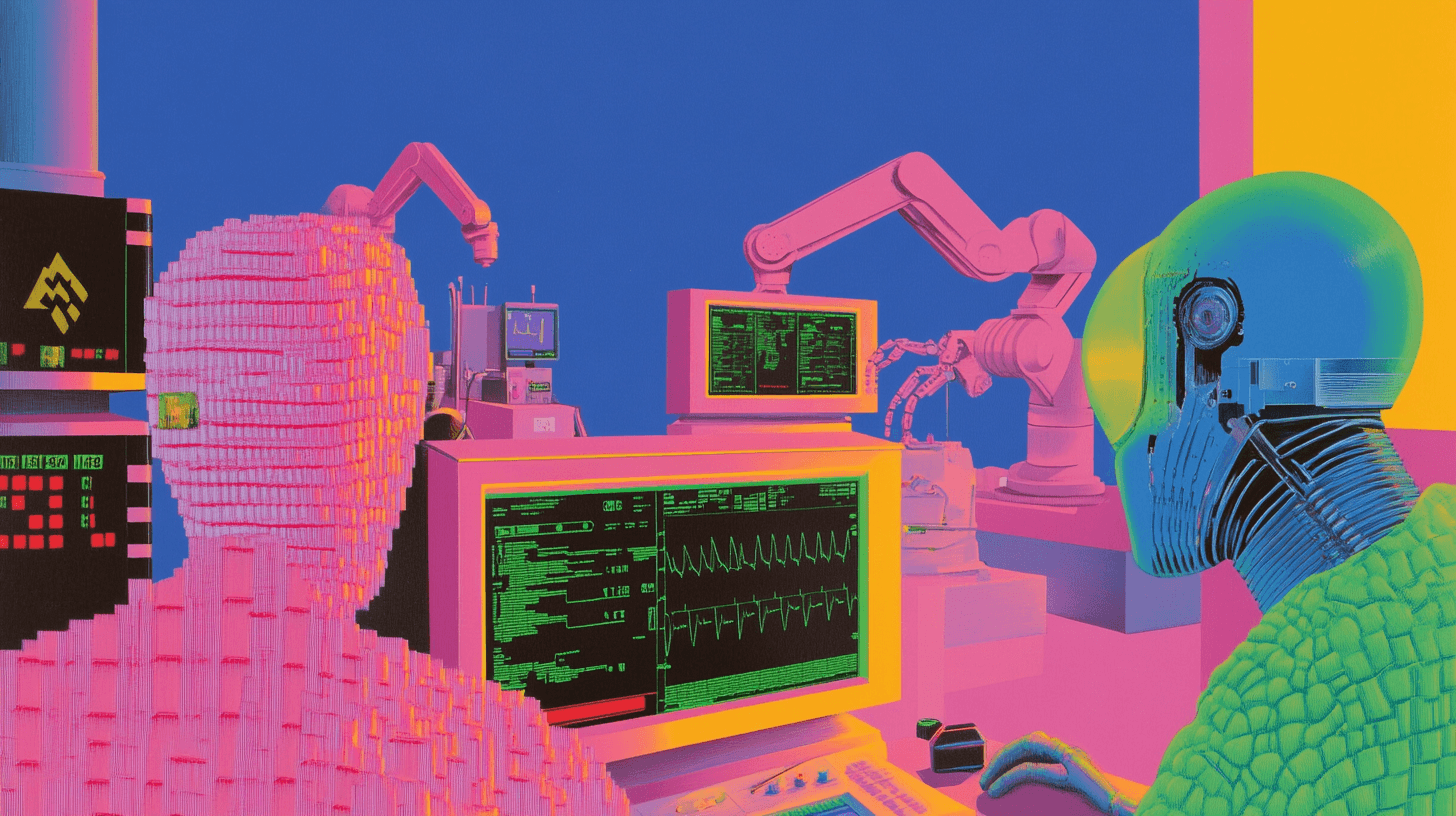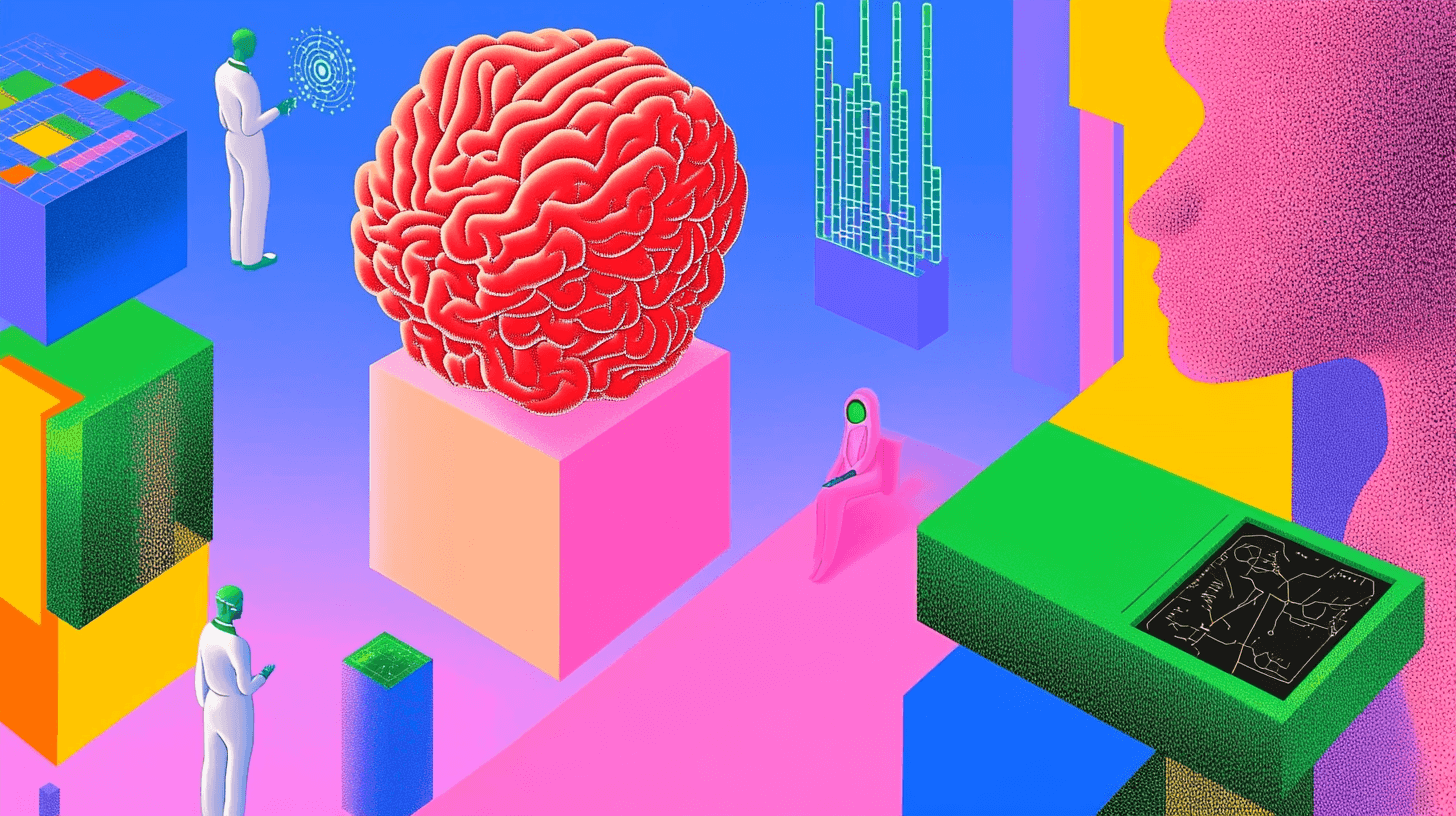What is AI in Healthcare?
Artificial intelligence (AI) in healthcare is the use of technological machines that have cognitive functions like thinking, learning, decision-making, and problem-solving in the medical field. The examples of such include understanding complex medical data, recognition of patterns in images or patient records, predicting health outcomes, helping with diagnostics, and supporting clinical decision-making.
In contrast to traditional software that is capable of performing only the tasks they are programmed to do, AI systems can still learn from data and improve their results without being explicitly programmed. In the context of healthcare, this not only provides a huge set of options for usage but also leads to more automation of medical teams—for example, the processing of X-rays and MRI scans with the highest level of accuracy, the prediction of patient deterioration in intensive care units, or the optimization of hospital logistics and resource allocation.
On the one hand, there is a shift to AI technology for conducting medical work such as diagnostics, which is only at the initial stage of using the new technology. On the other hand, the very nature of this change has disrupted the very nature of knowledge and skills that were hitherto commonplace in healthcare. The whole cybersecurity issue is inherently intertwined with this problem. Due to the lack of regulation and actors' accountability, problems with transparency, safety, and ethics frequently arise. Still, technologies and specialists maintain a close relationship, and one helps the other.
In this article, we will focus on three core aspects:
The risks and limitations associated with AI integration into healthcare systems.
The complexities and obstacles faced during real-world implementation.
And the practical value AI can deliver when used thoughtfully and responsibly.
In our exploration of the positive and negative implications of AI in the medical field, the objective is not to reject the technology, but rather to discover how it can be utilized securely, morally, and efficiently.
Limitations, Risks, and Uncertainties in Medical AI
AI technologies in the medical field have also become increasingly popular, but the situation with their integration into healthcare systems remains quite complicated. In addition to the potential benefits, AI also introduces several technical, ethical, legal, and practical risks. These risks of artificial intelligence in healthcare can affect not only the patients but also the doctors.
AI systems can be less than certain decision-makers in clinical environments due to the fact that they lack transparency in decision-making and can be biased in the data they use. Such risks are increased by the fact that there is no proper regulation, unclear responsibility in the event of an error, and the difficulty of fitting AI tools into the existing workflows.

The major changes that must happen in the health sector before AI can be really used there include the need to face these problems fully — prevention of harm and creating reliable, accurate, and patient-needs-aligned systems.
The Risk of Bias in AI-Driven Healthcare
One of the most significant issues with AI in healthcare is the possibility that it may replicate or aggravate the disparities in the health sector that already exist. The dangers of AI in healthcare are not caused by evil intentions but by the method of training and implementing AI systems. They usually depend on data that does not correctly reflect the entire diversity of the patient population. For instance, Hispanic/Latinx patients make up 18.5% of the U.S. population but only 1% of typical clinical trial participants (IBM).
AI models learn patterns based on historical data, but if that data reflects systemic inequalities — for example, underrepresentation of certain ethnic groups in clinical trials or gaps in electronic health records (EHRs) — the model will carry those biases into its predictions. Minority misrepresentation and data fragmentation can lead to serious consequences, such as incorrect diagnoses or inappropriate treatment recommendations for specific demographic groups.
The issue is not just limited to datasets. Such AI systems for resource allocation, which are typically used to forecast patients who might be in the highest need of care, can end up downgrading the importance of those who are vulnerable if their health records are incomplete or have been recorded using different standards. Along the same lines, AI systems of speech recognition might wrongly capture the voices of those who have regional accents or possess non-native speech patterns and thus be liable to make errors in the documentation or in the conversation with a patient.
Worse still, AI systems are often seen as "objective" by both clinicians and administrators, which can mask these biases and reduce critical oversight. This illusion of neutrality makes it harder to identify the systemic bias embedded in the algorithms. Moreover, if medical data is misused or subjected to data poisoning — whether intentional or accidental — the damage to diagnostic accuracy can be significant.
To mitigate these risks, developers and healthcare institutions must commit to:
Using representative data during model development.
Regularly auditing AI outputs across different patient groups;
Ensuring transparency around how models are trained and validated;
And acknowledging that bias is not a technical flaw, but a reflection of deeper inequalities within the healthcare system itsel
The Possibility of Misdiagnosis
AI systems in healthcare are usually cheered for their capacity to pick out patterns in complex medical data; however, they cannot avoid mistakes. The danger of wrong diagnosis or treatment recommendations is still the number one issue that needs to be addressed when it comes to AI implementation in medical facilities. A PMC study found that diagnostic errors occurred in 16 out of 146 patients (11.0%) when using an automated medical history-taking system (PMC).
These errors can stem from multiple sources. At the core is the medical algorithm itself — a system built on training data that may not cover all possible conditions, patient types, or scenarios. When the algorithm encounters unfamiliar or rare cases, it may make dangerously inaccurate predictions. In some cases, single-point failures in how data is handled or interpreted can lead to serious harm, including patient injury.
Beyond the model, technical infrastructure plays a crucial role. System malfunctions, data storage program failures, or IT breakdowns can disrupt care, critical decisions, or corrupt sensitive information. In more extreme cases, healthcare systems are increasingly vulnerable to ransomware crimes and malware attacks, which can lock clinicians out of essential systems or lead to the loss of medical records.
Another big problem of cons of artificial intelligence in healthcare is the question of who is responsible. The case of a recommendation error committed by an AI system is very typical; however, the issue of who is responsible often remains unclear: is it the developer, the hospital, or the individual clinician? This absence of clarity makes the situation more complicated in terms of both the law and ethical considerations when dealing with medical mistakes.
AI systems are just like people in that they have to be updated frequently if they are to be of any use. Models, without data re-training at regular intervals, can go downhill over time, which may cause them to give incorrect or dangerous recommendations. This issue is most significant in the rapidly evolving domains of the healthcare sector since any lag in updating can result in clinical decisions made based on old information.
Lastly, many healthcare institutions struggle with workflow vulnerabilities — the mismatch between AI tools and real-world clinical processes. If AI recommendations are not well integrated into medical routines or are misunderstood by practitioners, they may be ignored or misapplied, reducing their effectiveness or even causing harm.
To minimize the risk of clinical errors and risk of ai in healthcare, healthcare organizations must treat AI not as a standalone solution, but as a fallible tool that requires:
Continuous monitoring and evaluation ーAI models require frequent supervision and adjustments if they are to keep their forecast accuracy and relevance for the future.
Clear lines of responsibility ー It should be clear at any point who is responsible if an AI system issues wrong or harmful recommendations — the developer, the institution, or the clinician.
Robust data infrastructure and cybersecurity ー Trusted data systems and protection against threats from hackers are sine qua non to avoid technical failures and/or loss of data, which could negatively affect patient care.
Effective integration into clinical workflows ー Unless AI tools are simple to use and can naturally fit into a medical routine, they run the risk of being ignored or used incorrectly.
The Ethical and Legal Risks of AI in Healthcare
Ethical and legal issues are raised by the use of AI in clinical decision-making, which are complicated and extend beyond the technical capabilities of AI. AI systems are different from conventional medical instruments in that they not only can influence decisions, but also may decide those that directly change a patient's diagnosis, treatment, or even the care they need.
Informed consent is one of the principal issues. Patients might not decide completely if they are aware of the information about the role of AI in their treatment or about how their data is used to train or run these systems. If there is no openness, it is difficult to guarantee the respect of the patient's autonomy.
Privacy is another serious issue. AI systems require large volumes of data to function well, and much of that data is deeply personal. If not properly protected, it can be exposed to unauthorized access, misuse, or even ransomware attacks. Questions about data ownership and how long data should be stored remain unresolved in many regions.
The moral authority of AI is also debated. Should a machine ever be allowed to make life-or-death decisions? Even when AI systems are used only for recommendations, there’s the risk that overreliance on automated suggestions could reduce human oversight and accountability. As some researchers suggest, we may need a kind of "Hippocratic oath for computer scientists", emphasizing the moral duties of those who create and deploy medical algorithms.
Efforts are being made to address these issues. Some countries have started establishing ethics committees for digital science, and others are pushing for globally accepted AI ethics standards. Agencies like the FDA are also exploring regulatory pathways for medical AI, but significant gaps remain.
To reduce ethical and legal risks of ai in healthcare, the following steps are essential:
Implement methods that guarantee the understanding and consent of the patients
The patients must be unambiguously informed about the involvement of AI in their treatment as well as the usage of their data. The agreement must be clearly spoken, not implied.
Secure confidentiality with good data management practices
The health data that is very sensitive has to be protected with high-level security, it has to be anonymized if possible, and it can only be used according to strict rules.
Set up rules for legal responsibility for consequences caused by AI
The new rules have to be proposed, which will clearly show who is responsible if the AI system brings harm - developers, organizations, or practitioners.
Respect moral values while building and launching
Involvement of AI has to be consistent with the principles of medical ethics that have been recognized, the opinions of ethics committees have to be taken into consideration, and supervision has to be continuous.
Long-Term Risks and Uncertain Future of AI in Healthcare
Though lots of challenges of AI in healthcare have become apparent, there are still risks that could only come up later and are not easy to foresee or manage. As AI gets more and more sophisticated and deeply integrated into clinical settings, its effects in the long run might lead to new ethical, societal, and safety issues.
One concern is the rise of black-box medicine, where even developers and physicians cannot fully understand how an AI system reaches its conclusions. This reduces transparency and makes it difficult to question or improve decision-making processes.
Concerns about over-dependence on AI have also been raised, where physicians might blindly follow the algorithms, even for difficult cases that require human judgment. In a worst-case setting, some medical specialties can be lessened or completely substituted, resulting in deterioration of both care quality and professional growth.
Other emerging threats include hacking of medical datasets, data exposure, and even the potential misuse of AI to generate disinformation or interfere with biomedical systems. Some speculative but serious risks include the editing of the human genome by AI-driven systems, or the development of highly autonomous systems ("super AI") with unclear control mechanisms.
Though not all of these hazards are instant, the fast development of AI requires that the medical systems remain vigilant for new risks, as well as those that are still unclear.
To manage long-term risks and uncertainties, healthcare systems should:
Invest in long-term risk assessment and oversight
Regulatory bodies and institutions must actively monitor how AI evolves, including its social, ethical, and clinical effects.Avoid full dependency on AI for critical decisions
AI should assist — not replace — clinical judgment, especially in complex or high-stakes situations.Build systems for transparency and interpretability
Even advanced models must offer some form of explanation or logic that clinicians can understand and question.Plan for future-proof governance and safety controls
As AI capabilities grow, there should be international frameworks in place to address high-level threats, misuse, and loss of control.
System Errors and Technical Risks in Medical AI
In clinical settings, where time is of the essence, the reliability of AI systems holds equal value to their accuracy. However, several healthcare institutions still experience system stability problems, software vulnerabilities, and a lack of infrastructural support, among other challenges, according to the survey. AI systems require complex digital infrastructure to function properly. If any segment in this chain fails, it may lead to interruptions in care, s in treatment, or even patient injury (PSNet).
AI systems need complex digital infrastructure — such as data storage programs, networked servers, and real-time inputs from clinical devices — to function properly. If even one segment in this chain of events goes wrong, it may lead to interruptions in care, s in treatment, or even direct patient injury. The reasons for failures can be system malfunctions, software bugs, or single-point failures where a single error makes the entire system go down.
Security risks are of the same level of danger. Malicious software and ransomware canists. Healthcare systems are prime targets for such attacks that come with the aim to lock clinicians out of critical records or corrupt diagnostic tools. Furthermore, if the hospital system is taken down either by outdated technology or external attacks, the whole hospital might be paralyzed.
These risks are quite dangerous since once AI tools are put into use, they are regularly perceived, albeit wrongly, as trustworthy. Medical algorithms are constantly in need of upgrade, and if the software is not maintained properly, it can turn into something outdated, incompatible, or even unsafe.
Last but not least, the lack of deep integration with clinical routines makes workflow vulnerabilities even more significant: AI tools that do not fit into the everyday activities of medical personnel may be disregarded, misused, or, through misinterpretation, may even induce errors.
To reduce the risk of system failure and technical breakdowns, healthcare systems should:
Maintain and upgrade AI systems regularly
Outdated software increases the chance of errors — all systems should be actively maintained and updated to current standards.Build a strong IT and cybersecurity infrastructure
Reliable networks, secure storage, and protection against malware are essential for keeping medical AI tools functional and safe.Design systems with backup and failure controls
To prevent dangerous disruptions, systems should be prepared for hardware or software failure with safe fallback mechanisms.Test AI tools in real-world clinical workflows
AI must work reliably not just in theory, but in the actual routines of medical professionals — under pressure, time constraints, and real data conditions.
Data Privacy Challenges in AI-Powered Healthcare
With AI systems in the healthcare sector becoming more and more powerful, they need to be given access to large amounts of patient information. This information may include diagnoses, medical history, images, and even genetic data. This fact reflects the seriousness of the situation. There is, therefore, a dire need to protect the privacy of these patients, guarantee the security of their data, and utilize it in an ethically correct way.
Informed consent is one of the significant problems here. Generally, patients do not realize that their information is not only used for their treatment, but it is also possible it might be used for research, manufacturing, or handed over to partners for business purposes. Firstly, it is necessary to emphasize that even the anonymized data, if it is subjected to reidentification techniques, can be traced back to individual identities; thus, it is unclear how anonymous that data is.
Legislation like the HIPAA Privacy Rule in the U.S. and the California Consumer Privacy Act gives the parties involved some leverage; however, regulations are surpassed by the rapid change of AI projects. At the same time, the practice of sharing information between institutions or with parties that are not directly involved in the research increases the danger of data being used in unintended ways, where patient information is used for activities that deviate from the original purpose.
Additionally, there is a proliferation of cybercrime. Healthcare systems are the most common targets, and attacks may result in insurance fraud, identity theft, and loss of public trust due to privacy violations.
Privacy is not only a problem of technology, but it is a matter of ethics as well. The advancement in AI is going to continue, so naturally, the regulations concerning the methods of data collection, its storage, usage, and sharing should be revised accordingly.
To protect patient data and ensure proper consent, healthcare systems must:
Make informed consent clear, specific, and ongoing
Patients must know how their data will be used — not just once, but across time and changing systems.Apply strict privacy safeguards and legal compliance
Data systems must meet or exceed laws like HIPAA and include real enforcement, not just policy statements.Limit and monitor data-sharing with third parties
Transfers of data — even de-identified — should be tracked, restricted, and reviewed to prevent misuse or unintended access.Defend against cyber threats with advanced security
Hospitals and AI developers must invest in encryption, intrusion detection, and response systems to protect against breaches.
The integration of AI into healthcare offers significant opportunities, but it also introduces a wide range of risks — technical, ethical, legal, and societal. From biased algorithms and misdiagnoses to privacy breaches, system failures, and uncertain long-term consequences, these challenges cannot be ignored or underestimated.
What makes these risks particularly complex is that they are often interconnected. A technical failure may lead to patient harm; a lack of transparency may obscure ethical concerns; poorly secured data may lead to legal consequences. The promise of AI must be balanced with careful design, responsible use, and continuous oversight.
It is very important to identify these risks, but it does not mean that we are against AI — it is, in fact, an essential step in the process of creating reliable and secure systems. Medical care is a very sensitive area, and any tech that is incorporated there has to comply with the same high standards.
At the end of the day, it is not about hindering the innovation process but rather about steering it in the right direction. By finding these issues and solving them early, we can have AI systems that are genuinely helpful to the doctors, considerate of the patients, and that do not break the rules of safety and ethics while improving healthcare.
Case Studies: Real-World Applications of AI in Healthcare
In the previous sections, we explored the risks, drawbacks, and unknowns that came with the use of AI in healthcare. Though these concerns are valid and need to be dealt with, acknowledging the incredible AI potential that can save lives when the technology is put into practice is equally important.
AI systems from various parts of the globe have already shown their capability in cutting the time required for diagnosis, improving treatment accuracy, lowering the chances of medical errors, and providing assistance to the heavy workload of clinicians. It is worth noting that, in some instances, AI tools are not only making the process more efficient but are also saving lives directly.
These are the real-world case examples that feature victorious instances along with controversial failures, which provide helpful clues regarding the manner in which technology can be used — and ought to be used — in the field of medicine.
1. Google DeepMind & Moorfields Eye Hospital (Ophthalmology)
Overview & Outcome
DeepMind partnered with Moorfields Eye Hospital in London to develop an AI system that analyzes optical coherence tomography (OCT) scans to detect and triage retinal diseases, including age-related macular degeneration (AMD).
In various experiments, an AI system was found to make errors in deciding referrals at a level of 5.5% which is similar to the performance of expert clinicians. The AI additionally showed the potential to adapt to various OCT instruments with a small amount of retraining.

Lessons & Significance
The project caters to the "black box" problem by giving segmentation maps and pointing out the anatomical regions that are the source of the AI decision.
It demonstrates that AI augmentation in image-intensive areas can be at par with human performance if AI is developed using high-quality, annotated datasets.
If the architecture is flexible enough can be adapted to various imaging devices, then the scalability would be possible.
Source: IE University
2. IBM Watson for Oncology — A Cautionary Tale h3
Overview & Outcomes
Watson for Oncology was designed as a healthcare AI assistant, able to support cancer treatment decisions, with the first training at Memorial Sloan Kettering.
On the other hand, a number of news articles uncovered that Watson delivered hazardous or inaccurate suggestions for treatments in certain instances, notably when there were differences between the local protocols or drug availability and its database. Investigating the confidential IBM files, STAT found a connection between the mistakes and the insufficient and artificial training data that was used for the initial stage of training. STAT+1
Concordance studies of Watson vs. clinical practice have shown mixed results, varying across cancer types, and often relatively low agreement.
Over time, the initiative lost momentum, and IBM scaled back many Watson Health efforts.
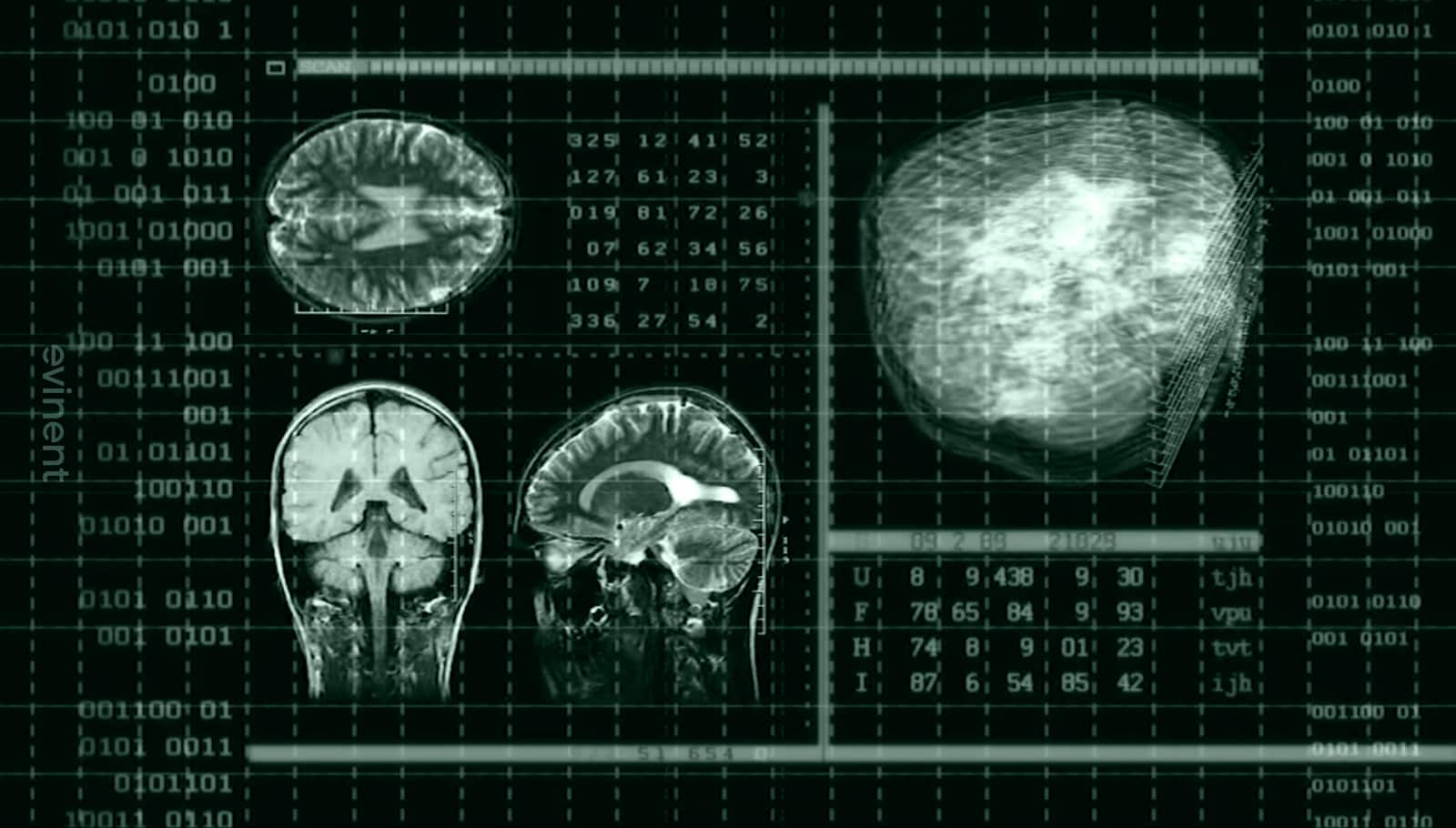
Lessons & Significance
In case an overpromise of certain capabilities with no serious validation in a real-world setting is conducted, the consequence that follows is a risk to the company's reputation.
Artificial intelligence models should be adapted to the local conditions and maintained regularly to be in line with the local rules, drug lists, and patient groups.
Disclosing the shortcomings of the technology-publicizing that the computer is a “helper, not a god,” is an indispensable part of the whole procedure.
Various regulations, both ethical and legal, should indicate clearly who the person in charge is when the AI guidance results in a negative impact.
Source: The ASCO Post
3. Aidoc in Radiology h3
Overview & Outcomes
Aidoc is an AI-powered platform that identifies critical findings (e.g., bleeding in the brain, blockage of the lungs) in CT scans to support radiologists. It has been allowed by the FDA for specific instances of use.
Aidoc has shown in healthcare that the time it takes to handle emergency cases is shortened, thereby the radiologists can manage their workflow quickly and more effectively. (Referred to in the imaging-AI industry reports).
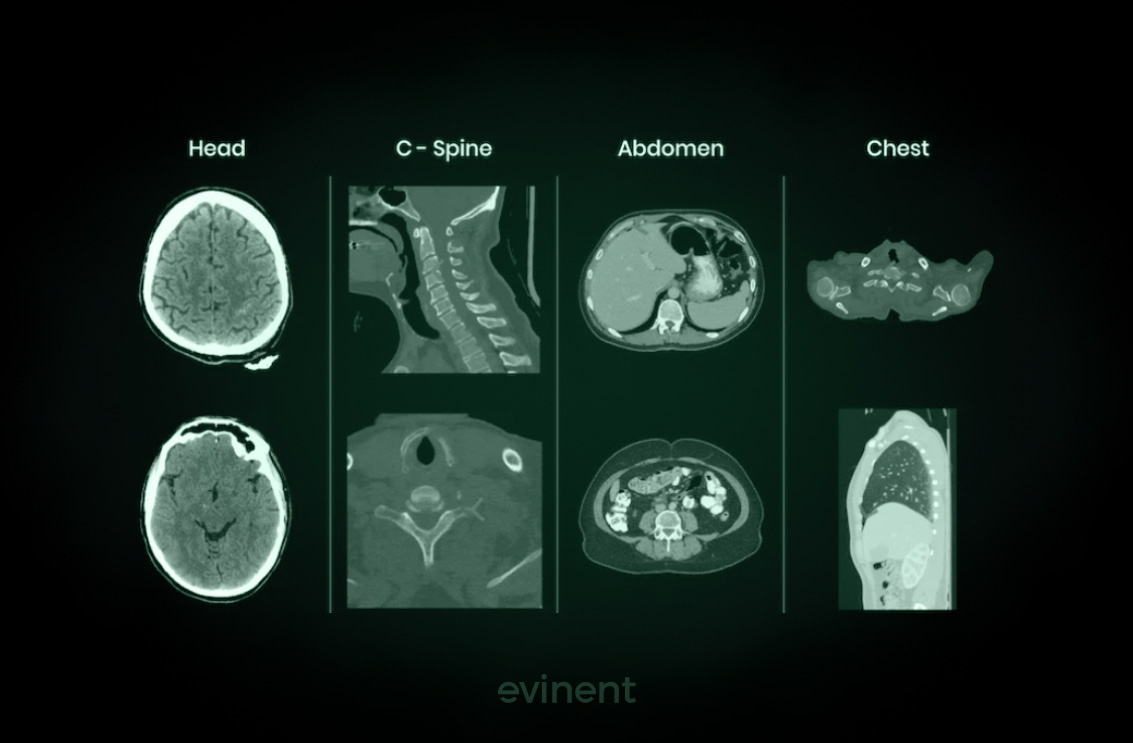
Lessons & Significance
Narrow, well-defined tasks (e.g. flagging critical findings) are often safer and more adoptable than trying to solve broad diagnostic problems.
FDA clearance (or regulatory approval) helps build trust and legitimacy.
Integration into radiologists’ workflows is key — the AI must deliver ing without interrupting routine work or causing fatigue.
Source: KLAS Research
To be brief, the use of AI in the healthcare sector requires the showing of humility when it comes to the design, use, and management phases. AI should always be a helpful device, rather than a substitute for human intelligence, particularly in such places as those that are concerned with the ethical treatment of patients, safety, and taking responsibilities. The onset of AI in the medical field will only be feasible if it is supported by solid technical quality and validation, appropriate administration, and allied human supervision.
Impact of AI on Medical Education and Workforce
The use of AI in the healthcare sector is changing the way that medicine is done, though it is still unclear how it will impact the training of future professionals and the roles they will accept. The following are the main points focusing on the fields where AI has made or is anticipated to make an impact in medical education and the healthcare workforce.
1. Shifting Roles: From Diagnostician to Supervisor
AI machines are progressively matching human capability in recognizing patterns and irregularities in imaging data in domains like radiology and pathology. Such computers do not replace the doctors; however, they change their role - instead of being the main diagnostician, they monitor the AI results, the decisions, and solve ethical problems by using the whole clinical input.
2. Curriculum Reform: Teaching AI in Medical School
Medical schools are beginning to rethink what future doctors need to know. Understanding how AI algorithms work, their limitations, and how to interpret their results is becoming as important as anatomy or pharmacology. However, many institutions still lack structured AI training, leaving graduates unprepared for modern clinical environments.
3. New Skills: Data Literacy and Algorithmic Thinking
Tomorrow’s doctors will need to be fluent in more than medical terminology. Skills like data interpretation, basic understanding of machine learning logic, and the ability to question algorithmic recommendations will become essential. This doesn’t mean turning doctors into programmers — but they must be critical users of AI tools, not passive consumers.
4. Workforce Inequality: Uneven Access to AI Training and Tools
AI technologies and related training are definitely not available to all healthcare professionals or institutions on an equal basis. This, of course, then leads to the potential of a "two-speed" workforce, where some doctors can cooperate with sophisticated AI systems, while the rest of the doctors are left without such opportunities. It is then easy to see that the outcome could be unequal care quality and the emergence of new forms of professional imbalance.
5. Professional Identity: Redefining What It Means to Be a Doctor
As AI takes over more routine or technical tasks, the human elements of medicine — communication, empathy, ethical judgment — become even more central. This shift forces a rethinking of medical identity: What defines medical professionalism in an age of intelligent machines?
6. Lifelong Learning: Adapting to Evolving Technology
Artificial intelligence is not static — it changes. This implies professionals in the healthcare sector will require learning on a continuous basis in order to remain updated with the latest tools, changes, and regulations. Medical societies and institutions have to assist them through the provision of easy and regular professional development.
AI won't take over the jobs of doctors; however, it will alter the kind of work doctors do, the way they are trained, and the most important skills. Education systems and healthcare organizations need to act beyond superficial technical excitement and concentrate on getting professionals ready to collaborate with AI, rather than being controlled by it, if they want to keep up with this change.
Managing the Risks of AI in Healthcare
The use of AI in clinical settings brings both promise and uncertainty. To ensure that AI systems improve care without causing harm, healthcare institutions must adopt clear, systematic strategies for identifying, managing, and reducing risks. This includes technical safeguards, ethical oversight, and policy-level coordination. Effective risk management requires not only reactive measures — like addressing errors — but also preventive mechanisms built into every stage of development, deployment, and daily use of AI in medicine.
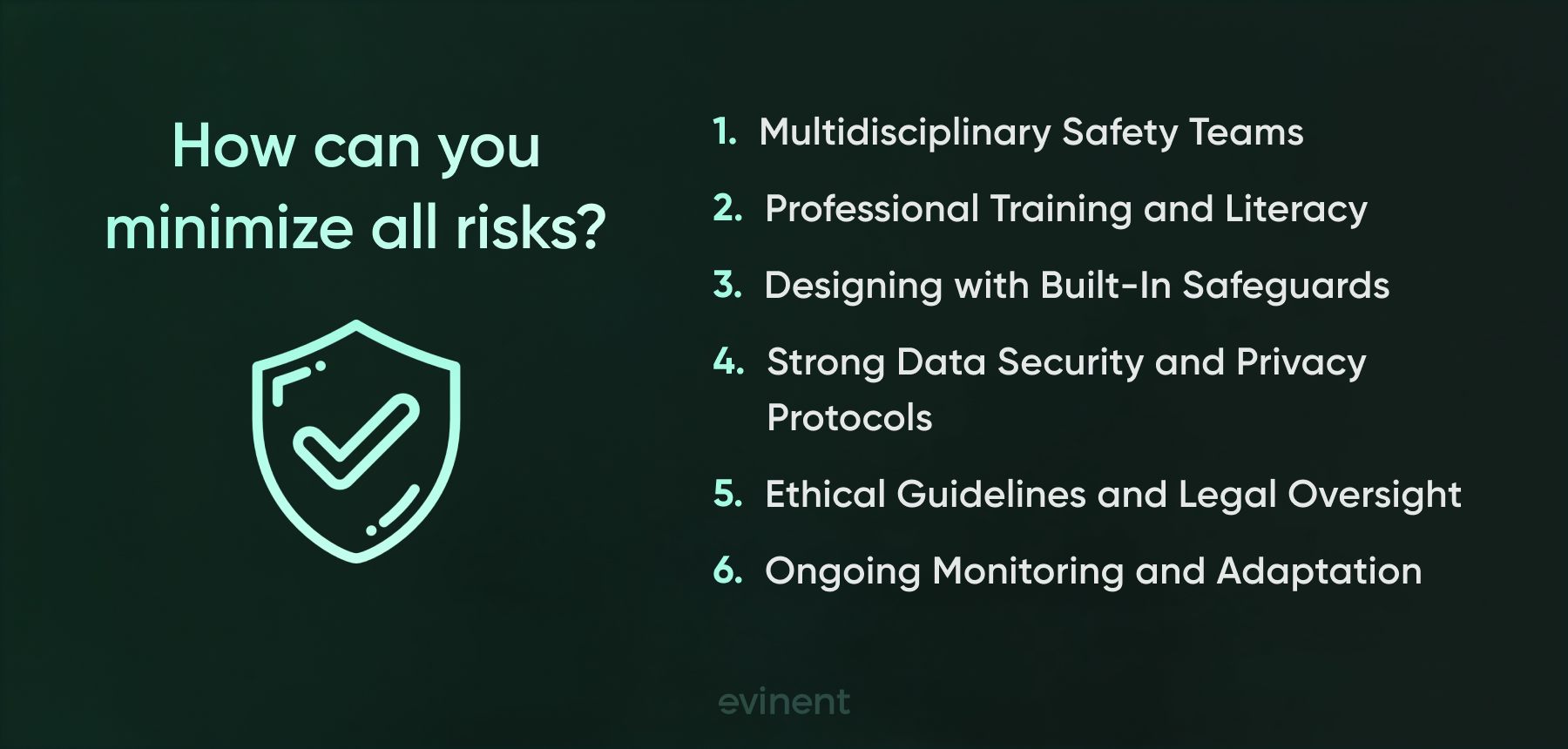
Below are three key areas that define responsible risk mitigation in AI-powered healthcare:
1. Multidisciplinary Safety Teams
AI systems should not be overseen by engineers alone. A safe and ethical implementation requires collaboration between clinicians, bioinformaticians, data privacy experts, cybersecurity professionals, and ethicists. These teams can assess risks from multiple perspectives and develop safeguards before a system reaches patients. This ensures that safety concerns are addressed holistically rather than from a narrow technical viewpoint.
2. Professional Training and Literacy
Healthcare personnel require specialized education in AI technology to enhance their communication skills with the AI system. Such knowledge is about algorithm operations, possible mistakes or inconsistencies, and decisions that have to be changed or informed. An adequately trained team of medical professionals makes sure that they are not falling into the trap of wrong diagnosis, misuse, or overreliance on the systems that they have not designed for independent operation through their actions.
3. Designing with Built-In Safeguards
AI devices have to have security safeguards fitted into them, like confidence indicators, warning signals for unfamiliar results, limits on usage of the out-of-scope, and a human full override capability. The people who make these systems have to give detailed and clear documents and invent transparent operation systems that allow the users to understand how the AI has come to its conclusion and decide if it is reasonable in the given situation.
4. Strong Data Security and Privacy Protocols
AI systems are definitely a boon for the healthcare sector, but they are also a bane because they are power-packed with sensitive data that makes them very attractive and high-value targets for hackers. To manage the risks effectively, it is necessary that access be tightly controlled, storage be encrypted, a number of audits be conducted, and response plans for breaches or failures be clearly outlined. Security of data cannot be left to chance; it needs to be a core and integral part of the design and execution.
5. Ethical Guidelines and Legal Oversight
Ethical and legal clarity are essential when machines are involved in patient care. This includes developing institutional review processes, establishing AI-specific clinical ethics boards, and adopting internationally recognized frameworks for responsibility and accountability. Without a legal and ethical infrastructure, assigning blame or correcting systemic issues becomes nearly impossible after something goes wrong.
6. Ongoing Monitoring and Adaptation
After deploying AI systems, they have to be constantly supervised and appraised. They might perform in such a way in real-world situations, which could expose new hazards that were not evident in the development or testing phase. It is very important to have periodic updates, keep track of results, and have feedback from the clinicians, as it will ensure that the tool is still safe and of good quality while the conditions are changing.
AI in healthcare cannot be treated like any other technology. Because it affects real patients, real decisions, and real lives, the margin for error is extremely narrow. Responsible implementation requires proactive strategies that combine technical safeguards, clinical expertise, legal structures, and continuous oversight. The goal is not to eliminate all risk, but to recognize it early, respond effectively, and make sure AI tools contribute to safer, more trustworthy care.
5 Benefits of using AI for your business
In spite of all the issues, AI has started to show its value in healthcare, only if it is used ethically. For enterprises operating in this domain — irrespective of whether they are hospitals, clinics, startups, or insurance providers — AI equips them with realistic benefits that have the potential to raise the level of care, cut down expenses, and form new kinds of efficiencies.
We hold the view that AI amplifies and augments, rather than replaces, human intelligence. Hence, when building AI systems in healthcare, it is key to not replace the important elements of the human interaction in medicine but to focus it, and improve the efficiency and effectiveness of that interaction.” — Google Health (quoted in Bajwa et al., Artificial Intelligence in Healthcare) (2021) | Bajwa J, 2021
Outlined here are the five most significant benefits that firms can receive from the utilization of AI in their healthcare business.
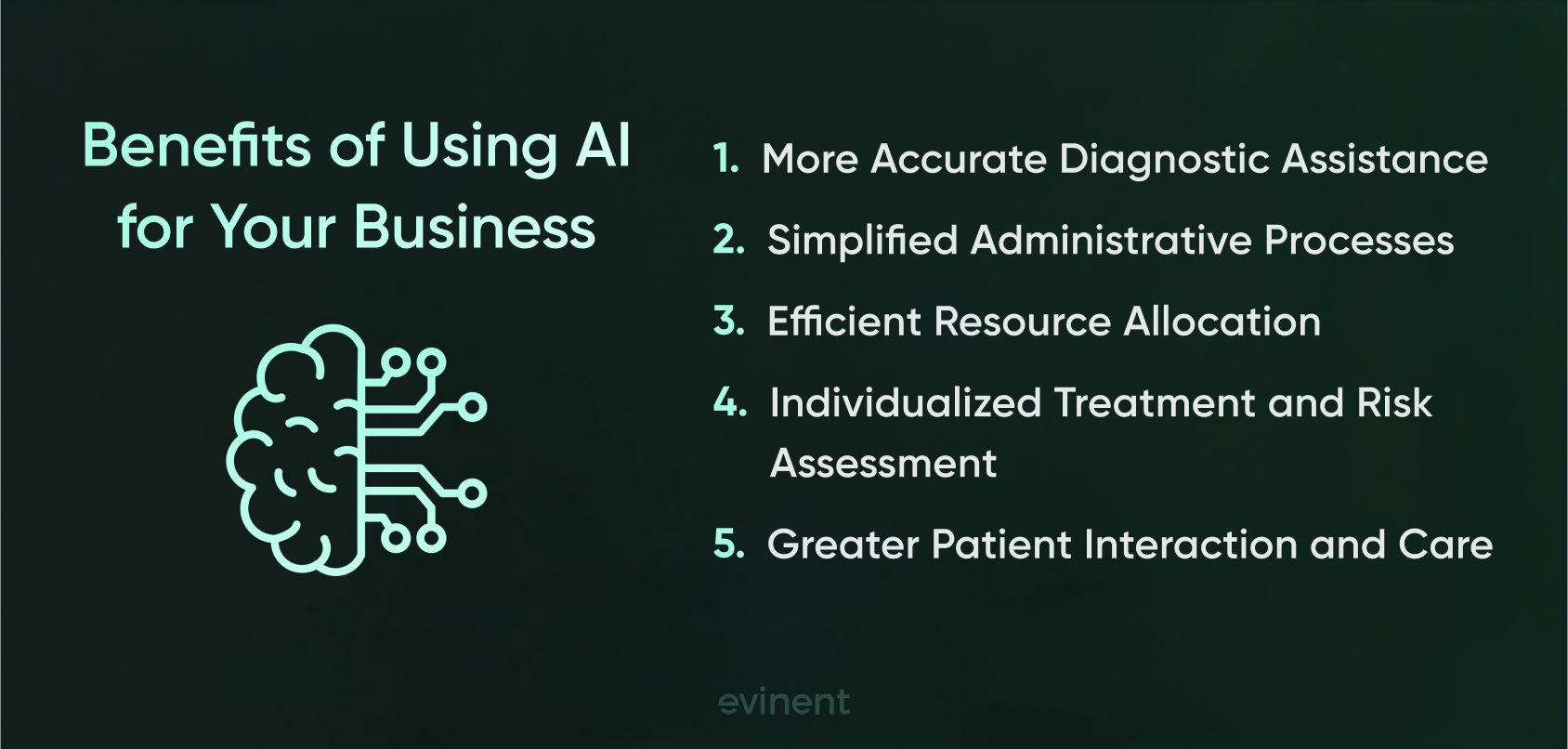
1. Improved Diagnostic Support
AI-powered systems can assist clinicians in interpreting scans, lab results, and health records with greater speed and consistency. In areas like radiology, ophthalmology, and pathology, algorithms have demonstrated the ability to detect signs of disease — sometimes earlier than traditional methods. Used properly, this support can reduce diagnostic s and help prevent medical errors.
2. Streamlined Administrative Tasks
It is a fact that AI systems can complete many tasks that are repetitive and require a lot of time – and here are some examples such as appointment scheduling, medical billing, claims processing, and paperwork management – more efficiently which, in turn, not only reduces the administrative burden but also decreases the possibility of human errors in documentation and reporting.
3. Optimized Resource Management
AI can help healthcare businesses make data-driven decisions about staffing, supply chains, patient flow, and equipment usage. By analyzing trends and forecasting demand, organizations can allocate resources more effectively and reduce waste — especially in hospitals with limited capacity or high patient volumes.
4. Personalized Treatment and Risk Prediction
AI can utilize an individual's health profile data to generate personalized treatment plans and also detect potential problems earlier than expected. A case would be using the predictive models to figure out the patients who are likely to be readmitted or the therapies that would be most effective based on biomarkers. This leads to care that is more proactive, targeted, and less expensive.
5. Enhanced Patient Engagement and Support
Chatbots, virtual assistants, and remote monitoring tools powered by AI can help patients stay informed, manage chronic conditions, and adhere to treatment plans. These tools provide accessible, 24/7 support and reduce unnecessary visits by offering reliable self-service for common concerns. As a result, businesses can improve patient satisfaction and reduce strain on clinical staff.
Artificial intelligence can deliver actual, tangible benefits to the healthcare industry if the implementation is done with care and consideration. It assists in error reduction, minimizes the administrative workload, aids in clinical decision-making, and enhances the patients' experience of care. Such benefits have become quite visible in a lot of medical environments. However, it is important that the gains are not obtained at the cost of irresponsibility. The AI has to be the decision-making assistant rather than the decision-maker and always emphasize safety, fairness, and transparency if it is to be useful in the future.
How Evinent can help with AI Healthcare Software Development
Indeed, AI has enormous capacity in healthcare. AI can help healthcare in a number of ways, such as improving interaction with healthcare providers, automating clinical operations, and supporting more appropriate decision-making. On the other hand, utilizing AI in healthcare is a double-edged sword as it creates complicated problems that involve privacy of data, compliance with regulations, reliability, and ethical accountability. These issues go beyond just technical ones — they are obstacles that might hinder the pace of innovation or even create a scenario where patients get injured.
Our company, Evinent, is where we stand for you to fully enjoy the advantages of AI, as well as having the capability to mitigate the risks. We have over 15 years of experience in custom software development and a proven track record in AI integration for healthcare. We deliver full-cycle, domain-specific solutions that are safe, compliant, and clinically meaningful.
We can help you whether you're a hospital wanting to improve health outcomes or a digital health company creating a new product. We provide strategic assistance at every step - from the beginning of the planning stage to the secure deployment of the product.
What Makes Evinent Different
We don’t just develop AI features. We build healthcare-grade intelligent systems that integrate with your workflows, align with medical regulations, and actually solve real clinical problems.
Area | How We Help |
AI for Diagnostics | Tools that detect patterns in medical images or lab data to support faster, more accurate diagnoses. |
Predictive Modeling | Algorithms that assist in the prediction of disease development, resource requirements, or potential patient hazards — thereby enhancing the capacity for better planning and prevention. |
Natural Language Processing (NLP) | Extraction of key data from unstructured clinical notes, EHRs, and patient feedback to support evidence-based decisions. |
AI-Powered Chatbots | Virtual assistants that can be used for triage, after-visit support, or directions for patients — thereby decreasing staff workload and making access easier. |
MLOps & Monitoring | Continuous performance monitoring, retraining, and model governance to ensure safety and dependability throughout the period. |
Custom AI Model Development | Building models tailored to your data, use case, and environment — including vision, recommendation, and prediction tools. |
Full-Cycle AI Development — With Risk in Mind
We start with a discovery phase to understand your clinical goals, data landscape, and compliance environment. From there, we handle everything — data preparation, model development, testing, and post-deployment monitoring.
Because we know the risks, we don’t take shortcuts. Our process includes:
Strong data governance and security controls
Adherence to healthcare compliance standards
Human-in-the-loop validation where required
Scalable and modular architecture for future growth
Our goal is not just to deploy AI — but to deploy it safely, responsibly, and in a way that creates measurable value.
Secure and Intelligent Medical Coding Platform
One of our healthcare clients was in need of a solution to minimize medical coding errors and also speed up the process. We developed an AI-based system that facilitated instant interaction between the coders and doctors, increased the accuracy of the codes, and also ensured the data was kept safe.
The problem: in the approval of claims, unproductive communication, and very stringent data security regulations.
The way we fixed it: A coding platform online that had real-time features, role-based access control, and secure authentication.
The results:
33% faster staffing cycle
Fewer rejected claims and faster reimbursements
Consistent cross-device performance
Enterprise-grade data protection
Why Healthcare Organizations Choose Evinent
100% project success rate
20M+ end users impacted
78% enterprise clients
15 years of software development experience
If your institution has the intention of employing AI securely — such as in diagnosing, automating workflow, or improving patient experience — Evinent is the collaborator that merges health care insight with technical skills profoundly. We are not only software developers, but also the ones who assist you in innovating while still maintaining safety, ethics, and compliance.
Reach out to us for a consultation on how we could be of assistance in implementing AI in the healthcare sector, the best way.


